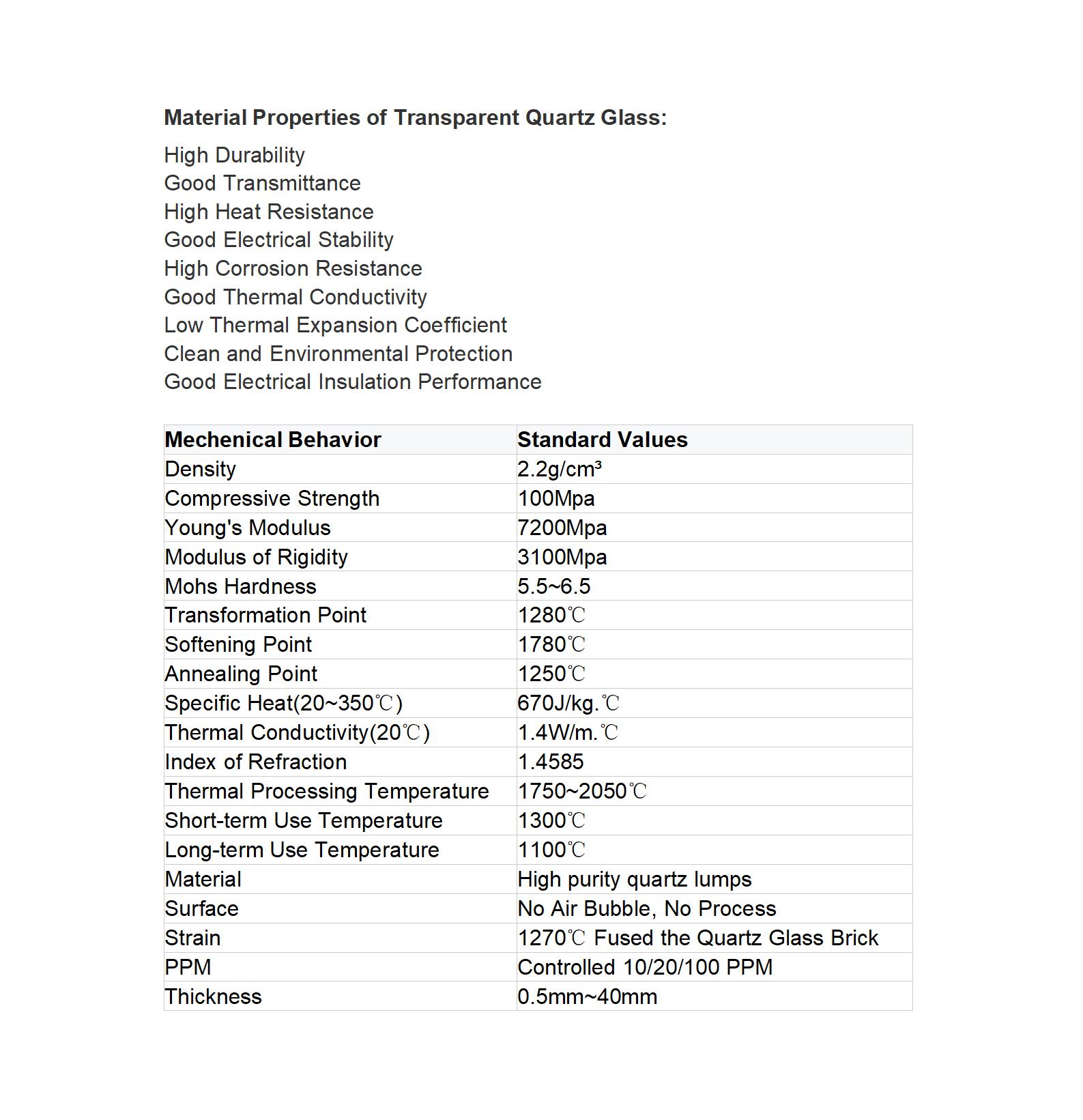T: +86-518-85528012
E: nick@luverrequartz.com
E: nick@luverrequartz.com
1st floor Runlian industrial center No. 116 QuFeng Rd., Haizhou Economic and technological development zone Lianyungang City, Jiangsu Province, China 222062
High purity food laboratory quartz glass tube
High purity food laboratory quartz glass tube is a special industrial technology glass, mainly composed of silicon dioxide (SiO ₂), melted from high-purity natural quartz (such as crystal, quartz sand).
LUVERRE quartz
99.99%
Inner with Vacuum PVC bag and then wrapped with air bubble film, outer with wooden box.
as per customer's requirement
| Availability: | |
|---|---|
High purity food laboratory quartz glass tube
High purity food laboratory quartz glass tube is a special industrial technology glass, mainly composed of silicon dioxide (SiO ₂), melted from high-purity natural quartz (such as crystal, quartz sand). It is known as the "King of Glass" due to its excellent properties that ordinary glass cannot match. The coefficient of linear expansion of quartz glass is extremely small, only 1/10~1/20 of that of ordinary glass, which allows it to maintain stable performance in high temperature environments. It also has excellent thermal shock resistance, able to maintain stability at extreme temperatures of 1100 to 1200, and even withstand high temperatures up to 1400 in the short term.

The quartz glass tube is composed of a single component of silicon dioxide, and its structure is formed by tightly arranged tetrahedral units of silicon dioxide sharing oxygen atoms to form a continuous three-dimensional network. This amorphous structure endows quartz glass with many unique physical and chemical properties, such as excellent spectral transparency, extremely low thermal expansion coefficient and conductivity, as well as outstanding radiation resistance and durability under extreme conditions.
Quartz glass tubes have a wide range of applications, including but not limited to high-temperature furnaces, semiconductor manufacturing processes, lighting solutions, and laboratory equipment. In high-temperature furnaces, quartz glass tubes can withstand high temperatures and pressures, while also having good corrosion resistance and wear resistance. In semiconductor manufacturing processes, it can provide high-purity gas and liquid transport, ensuring the stability and quality of the production process. In lighting solutions, quartz glass tubes can provide efficient and stable optical transmission and reflection, while also having good temperature and light resistance. In laboratory equipment, it can provide high-precision and high stability measurement and analysis, while also having good corrosion resistance and wear resistance.

Quartz glass tubes have advantages such as high purity, excellent spectral transmittance, and good size control. Its low hydroxyl content improves overall quality and performance. Quartz glass tubes also have strong thermal shock resistance, with minimal expansion or contraction during temperature fluctuations, making them very durable. In addition, it has high transparency to ultraviolet radiation and a refractive index lower than other types of glass, making it an ideal material for optical applications. This type of glass tube is widely used in fields such as semiconductors, metallurgy, chemical engineering, electric light sources, optical communication, medical equipment, and scientific instruments.
High purity food laboratory quartz glass tube
High purity food laboratory quartz glass tube is a special industrial technology glass, mainly composed of silicon dioxide (SiO ₂), melted from high-purity natural quartz (such as crystal, quartz sand). It is known as the "King of Glass" due to its excellent properties that ordinary glass cannot match. The coefficient of linear expansion of quartz glass is extremely small, only 1/10~1/20 of that of ordinary glass, which allows it to maintain stable performance in high temperature environments. It also has excellent thermal shock resistance, able to maintain stability at extreme temperatures of 1100 to 1200, and even withstand high temperatures up to 1400 in the short term.

The quartz glass tube is composed of a single component of silicon dioxide, and its structure is formed by tightly arranged tetrahedral units of silicon dioxide sharing oxygen atoms to form a continuous three-dimensional network. This amorphous structure endows quartz glass with many unique physical and chemical properties, such as excellent spectral transparency, extremely low thermal expansion coefficient and conductivity, as well as outstanding radiation resistance and durability under extreme conditions.
Quartz glass tubes have a wide range of applications, including but not limited to high-temperature furnaces, semiconductor manufacturing processes, lighting solutions, and laboratory equipment. In high-temperature furnaces, quartz glass tubes can withstand high temperatures and pressures, while also having good corrosion resistance and wear resistance. In semiconductor manufacturing processes, it can provide high-purity gas and liquid transport, ensuring the stability and quality of the production process. In lighting solutions, quartz glass tubes can provide efficient and stable optical transmission and reflection, while also having good temperature and light resistance. In laboratory equipment, it can provide high-precision and high stability measurement and analysis, while also having good corrosion resistance and wear resistance.

Quartz glass tubes have advantages such as high purity, excellent spectral transmittance, and good size control. Its low hydroxyl content improves overall quality and performance. Quartz glass tubes also have strong thermal shock resistance, with minimal expansion or contraction during temperature fluctuations, making them very durable. In addition, it has high transparency to ultraviolet radiation and a refractive index lower than other types of glass, making it an ideal material for optical applications. This type of glass tube is widely used in fields such as semiconductors, metallurgy, chemical engineering, electric light sources, optical communication, medical equipment, and scientific instruments.